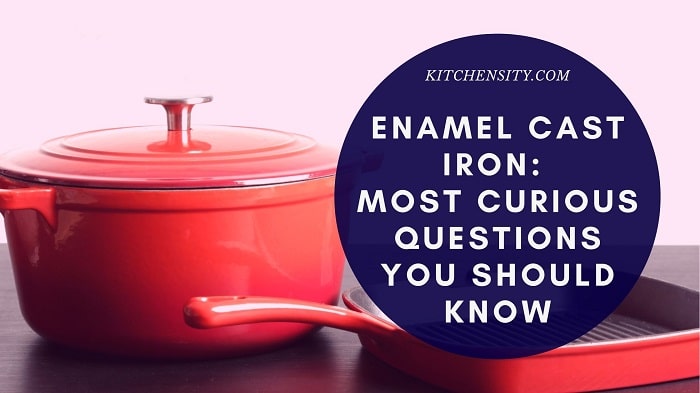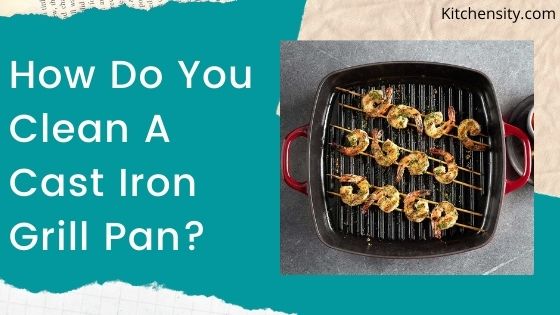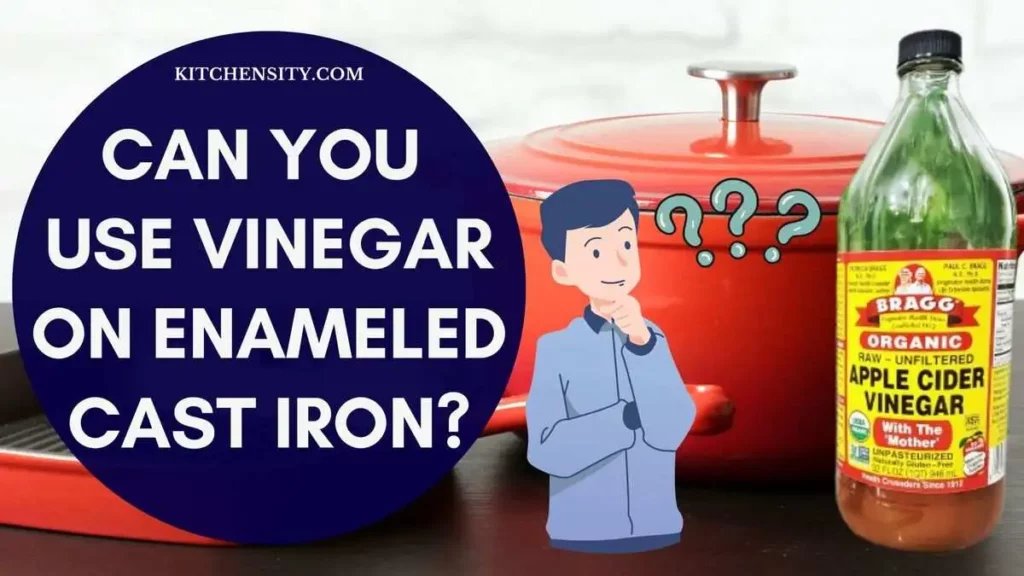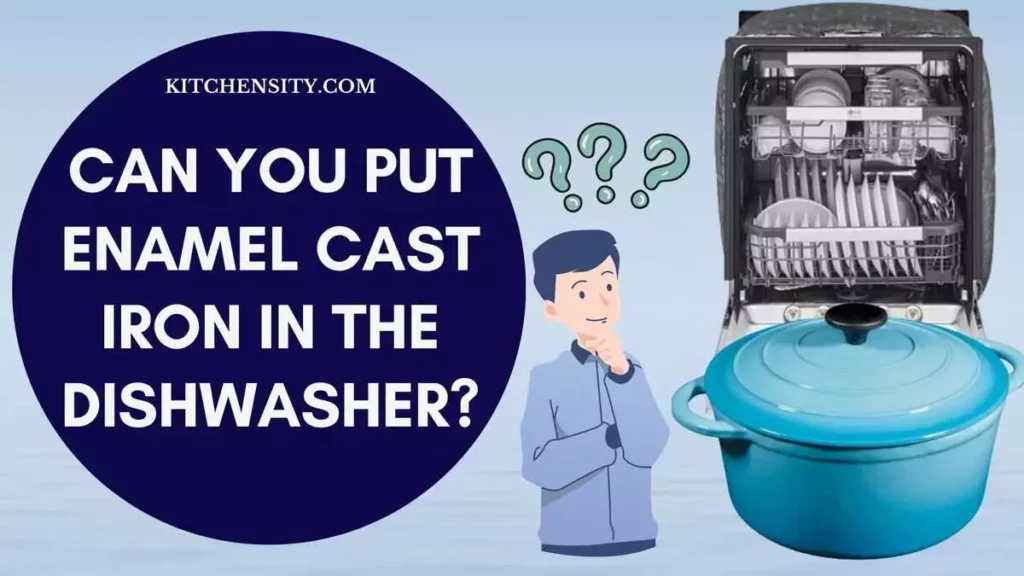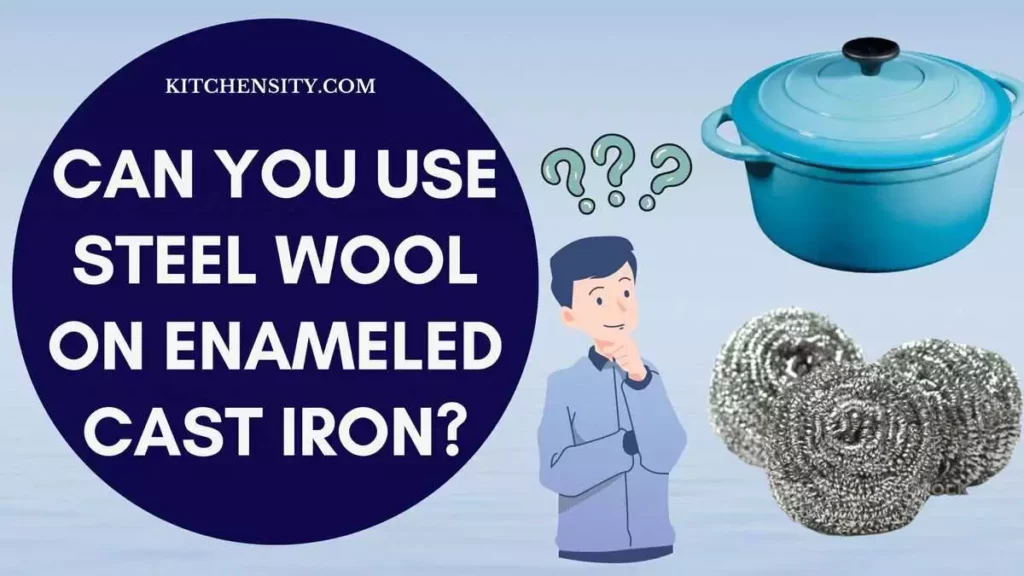In the world of cooking, few materials are as beloved as cast iron for its durability and heat retention. However, when it comes to enamel-coated cast iron, questions arise about its resilience and safety. This article aims to eliminate common myths and provide clarity on crucial questions such as, “Does enamel cast iron chip?” and “Is it safe to use a chipped Dutch oven or Enamelware?“
One of the most pressing concerns for users of enamel-coated cast iron is whether the enamel can chip during regular use. While enamel is generally durable, it is not indestructible. Factors such as the quality of the enamel coating, how the cookware is used and cared for, and the presence of any manufacturing defects can all impact its resilience.
Table of Contents
- 1 Does Enamel Cast Iron Chip?
- 2 Reasons For Enamel Cast Iron Getting Chipped
- 3 Is It Safe To Use A Chipped Dutch Oven?
- 4 How To Avoid Chipping Of Enamel Cast Iron Cookware?
- 5 Can You Still Use A Chipped Enamel Pot?
- 6 Can You Use A Cracked Enamel Dutch Oven?
- 7 Is Scratched Enamel Cookware Safe?
- 8 How To Repair Chipped Enamel Cast Iron Cookware?
- 9 Health Implications Of Using Chipped Enamel Cast Iron Cookware
- 10 Final Thoughts: Does Enamel Cast Iron Chip?
- 11 Frequently Asked Questions (FAQ’s)
- 11.1 Is Chipped Enamel Cast Iron Safe?
- 11.2 How Long Does Enameled Cast Iron Last?
- 11.3 Can I Use My Chipped Le Creuset Cookware?
- 11.4 Can You Use Metal On Enameled Cast Iron?
- 11.5 Is It Safe To Use Old Cast Iron Pots With Bad Enamel Coating?
- 11.6 Can You Re-Enamel A Cast Iron Pot?
- 11.7 Can Le Creuset Enamel Be Repaired?
Does Enamel Cast Iron Chip?
Enamel-coated cast iron cookware can chip if subjected to hard impacts, extreme temperature changes, or stacked improperly. While chipping does not necessarily affect the safety of the cookware, it can compromise its long-term durability and affect its visual appeal.
Proper care, including avoiding impacts and extreme temperature changes, as well as storing the cookware carefully to prevent stacking-related damage, can help minimize the risk of chipping. Also, following the manufacturer’s care instructions for cleaning and maintenance can extend the life of the enamel coating and reduce the likelihood of chipping.
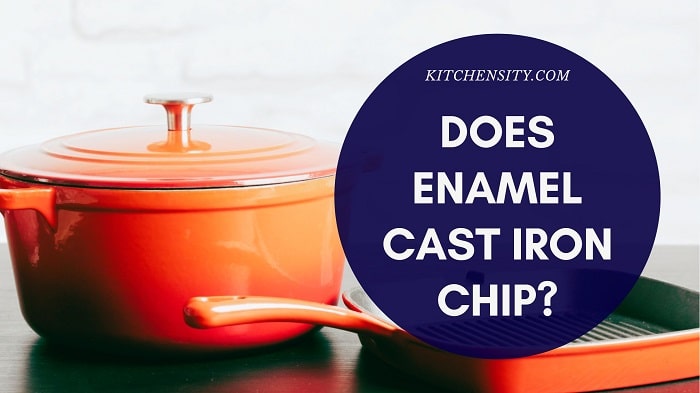
Also Read – Is Enameled Cast Iron Cookware Safe?
Here are some statements from reputable sources and manufacturers regarding the durability of enamel-coated cast iron:
- Le Creuset: According to Le Creuset, a well-known manufacturer of enamel-coated cast iron cookware, their products are designed to be durable and long-lasting. They state that their enamel coatings are resistant to chipping and cracking under normal use when cared for properly.
- The Kitchn: The Kitchn, a popular cooking and food website, mentions that enamel-coated cast iron is generally sturdy and less prone to chipping compared to traditional cast iron. They emphasize that proper care, such as avoiding metal utensils and abrasive cleaners, can help maintain the enamel coating’s integrity.
- Consumer Reports: Consumer Reports, a trusted source for product reviews and recommendations, has highlighted the durability of enamel-coated cast iron in various cookware reviews. They often note that high-quality enamel coatings are resistant to chipping and provide long-term usability with proper care.
Reasons For Enamel Cast Iron Getting Chipped
While I mentioned that enamel cast iron cookware can get chipped due to hitting it hard with metal utensils or subjecting it to crazy temperature swings, several other factors can cause chipping. It is important to be aware of them to prevent damage to your cookware. Here are some additional details:
1. Dropping The Cookware On A Hard Surface:
- Enamel cast iron cookware is heavy and can be difficult to handle, especially when it is filled with hot food.
- Dropping the cookware on a hard surface can cause chips or cracks in the enamel coating.
- It is important to handle the cookware with care and use both hands to lift and move it when necessary.
2. Stacking It Improperly With Other Cookware:
- When storing your enamel cast iron cookware, it is important to stack it carefully to prevent chipping.
- Stacking heavy cookware on top of each other can cause the enamel coating to chip or crack.
- It is recommended to use pot protectors or towels between the cookware to prevent damage.
3. Using Abrasive Cleaners:
- Abrasive cleaners and scrubbers can scratch and damage the enamel coating on your cookware, leading to chipping or cracking.
- It is recommended to use non-abrasive cleaners and soft sponges or brushes to clean the cookware.
- Additionally, soaking the cookware in warm, soapy water can help loosen any food particles or stains, making it easier to clean.
By being aware of these additional factors that can cause chipping and taking care to prevent them, you can help extend the life of your enamel cast iron cookware and prevent damage to the enamel coating.
Also Read – Best Enameled Cast Iron Cookware Sets
Is It Safe To Use A Chipped Dutch Oven?
Using a chipped Dutch oven is not recommended for several reasons.
- Firstly, a chipped enamel surface can expose the underlying cast iron, which may lead to rusting and compromise the integrity of the cookware.
- Secondly, cooking with a chipped Dutch oven can raise concerns about the potential release of harmful substances into food.
- Even if the chipped area seems small, it’s best to avoid using the Dutch oven for cooking to ensure food safety and maintain the quality of the cookware. Instead, consider repairing or replacing the Dutch oven to ensure safe and effective cooking.
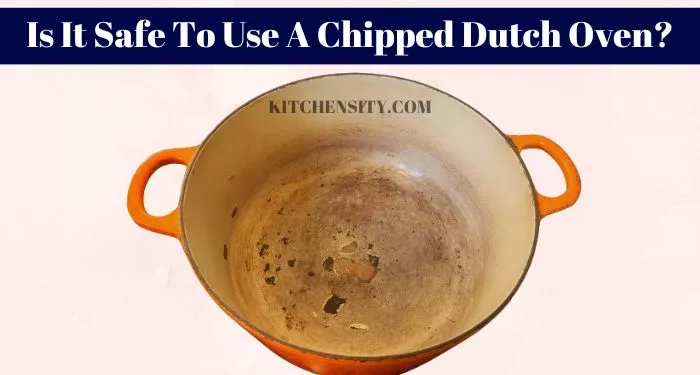
How To Avoid Chipping Of Enamel Cast Iron Cookware?
In the first few paragraphs, I have already told you that if you hit your cookware hard with metal or something strong or are subject to crazy temperature swings, then it can get chipped. But, there are also certain things that you have to keep in mind to avoid chipping your enameled cast iron cookware.
- Avoid scrapping metal utensils across the bottom of the pan. Your cookware can get deep scratches and chipped. Always try to use wooden or silicone utensils.
- Avoid clearing food from the utensils by whacking them on the rim of the cookware. This is one of the major reasons for chipping. You can use your hand to whack the utensil to clear food.
- Do not empty your pots and pans. Always use high heat when you are boiling water or using plenty of liquid for cooking. Otherwise, try to cook in medium to low heat as it is an excellent conductor of heat.
- After cooking, don’t put your cookware immediately under cold water. This dramatic temperature change can chip your pots and pans easily.
If you avoid all these things, then your enameled cast iron cookware will last for decades.
Also Read – Why Does Food Stick To My Enamel Cast Iron?
Can You Still Use A Chipped Enamel Pot?
Yes, you can still use a chipped enamel pot, but it’s important to proceed with caution. Even if the enamel coating is chipped, the raw cast iron underneath is safe for use. However, before using the pot, it’s crucial to clean it thoroughly to remove any loose enamel pieces that could potentially mix with your food. Use a cloth to gently clean the surface before using the pot to ensure that it is safe for cooking.
Keep in mind that while the pot may still be usable, the chipped enamel can compromise its overall durability and appearance. Regularly inspect the pot for further chipping or damage and consider repairing or replacing it if necessary.
More Tips To Avoid Chipping
Here are some additional tips to avoid chipping enamel cast iron cookware:
- Use Appropriate Utensils: Avoid using metal utensils when cooking or serving in an enamel cast iron cookware. Instead, use wooden, silicone, or nylon utensils to prevent scratches and chips.
- Avoid Temperature Shocks: Avoid subjecting your enamel cast iron cookware to extreme temperature changes. For example, don’t transfer hot cookware directly to a cold countertop or sink. Always use a trivet or hot pad to place your hot cookware on.
- Avoid Stacking Cookware: Do not stack enamel cast iron cookware on top of each other. Instead, store them separately, with a protective layer between them to avoid scratches.
- Clean The Cookware Gently: Avoid using abrasive cleaners or scrubbers on enamel cast iron cookware. Instead, use a soft sponge or cloth with mild soap and water to clean the cookware. Avoid using the dishwasher as it can damage the enamel coating.
- Avoid Acidic Foods: Avoid cooking acidic foods in an enamel cast iron cookware for an extended period. The acidity can cause the enamel to break down, resulting in chipping or cracking.
- Don’t Drop The Cookware: Accidents happen, but dropping enamel cast iron cookware can result in chipping or cracking. Be careful when handling the cookware, and if you accidentally drop it, inspect it for any damage before using it again.
By following these tips, you can help prevent chipping in your enamel cast iron cookware, making it last longer and remain in excellent condition.
Also Read – Can You Use Vinegar On Enameled Cast Iron?
Can You Use A Cracked Enamel Dutch Oven?
Using a cracked enamel Dutch oven is not recommended. Cracks in the enamel coating can compromise the integrity of the pot and potentially lead to further damage. Also, cooking with a cracked enamel Dutch oven can raise concerns about the release of harmful substances into food. It’s best to discontinue using a cracked enamel Dutch oven and consider repairing or replacing it to ensure safe and effective cooking.
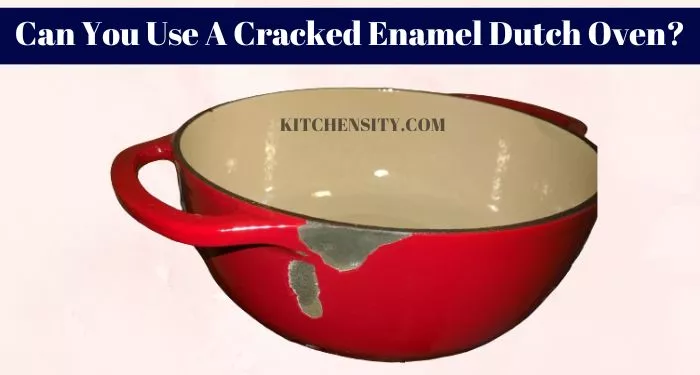
According to general food safety guidelines, using cookware with compromised surfaces, such as cracked enamel, can pose a risk to food safety. Cracks can create areas where bacteria can thrive and may lead to contamination of food cooked in the pot.
Many users who have encountered cracked enamel on their Dutch ovens report concerns about the safety and effectiveness of the cookware. They often opt to discontinue use or seek repairs or replacements to ensure safe cooking practices.
Is Scratched Enamel Cookware Safe?
Scratched enamel cookware can still be safe to use, but it’s essential to assess the extent of the scratching and take appropriate precautions. Minor surface scratches that do not expose the underlying metal are generally safe, but deeper scratches that penetrate the enamel layer can raise concerns about potential food contamination and damage to the cookware.
Here are some factors to consider:
- Depth of Scratches: Superficial scratches that only affect the surface of the enamel are less likely to impact the safety of the cookware. However, deep scratches that reach the metal underneath may compromise the integrity of the enamel and should be carefully examined.
- Maintenance and Cleaning: Proper cleaning and maintenance of scratched enamel cookware are crucial for ensuring its safety. Thoroughly clean the cookware after each use to remove any food particles that may have accumulated in the scratches.
- Cooking Precautions: When using scratched enamel cookware, consider using utensils that are gentle on the surface, such as wooden or silicone utensils, to avoid further scratching. Avoid cooking acidic foods for prolonged periods in scratched enamel cookware, as the acidity can potentially interact with the exposed metal.
- Regular Inspection: Regularly inspect the cookware for any signs of worsening or deepening scratches. If you notice significant deterioration or an increase in the number of scratches, consider replacing the cookware to maintain safety standards.
Also Read – Can You Put Enamel Cast Iron In The Dishwasher?
How To Repair Chipped Enamel Cast Iron Cookware?
I don’t recommend repairing your chipped cookware but if you insist there is a temporary solution to that. If your pot is chipped badly, then you may contact the manufacturer for replacement as most of them will do it for free. If not, then you need to buy a new one.
So, here is the method to fix it temporarily.
Materials Required
- Food Grade Enamel Repair Kit
- Fine-Grit Sand Paper
- A Soft Cloth
- Wax Paper (If you are not getting with the kit)
- Dishwashing Liquid
Steps To Fix
- First, clean the cookware properly to remove any loose enameled particles.
- Now, use the food-grade epoxy solution to gently fill the gaps. Try to fill all the affected parts.
- Once the epoxy has begun to harden slightly, place a piece of wax paper over it. Apply gentle pressure to the wax paper, flattening the epoxy solution against the cookware.
- Now, remove the wax paper and let the solution dry completely.
- Once it dried, gently sand the repaired area to match the surrounding edges.
- After that, clean the cookware properly with a dishwasher to remove any unwanted particles. Or you can also any food-grade enamel paint to match the color of your cookware.
Also Read – How To Re-Enamel Le Creuset Cookware?
How To Fix Chipped Enamel Dutch Oven?
If your enamel Dutch oven has a small chip or two, it may still be safe to use, but it’s best to repair the chips as soon as possible to prevent any further damage.
Here are the steps you can follow to fix chipped enamel on a Dutch oven:
- Clean The Dutch Oven: Start by cleaning the Dutch oven thoroughly to remove any dirt, grease, or debris that may be present in the chipped area. Use soap and water, and dry the Dutch oven completely.
- Sand The Chipped Area: Using fine-grit sandpaper, gently sand the chipped area to remove any sharp edges or rough spots around the chip. Make sure to remove any loose or flaking enamel as well.
- Apply Enamel Repair Compound: Apply a small amount of enamel repair compound to the chipped area, spreading it evenly with a brush or a spatula. Be careful not to apply too much or it may take longer to dry.
- Let It Dry: Allow the enamel repair compound to dry completely. It may take a few hours or overnight, depending on the manufacturer’s instructions.
- Sand The Repaired Area: Once the repair compound has dried, use the fine-grit sandpaper again to smooth out the repaired area until it’s even with the surrounding enamel. Wipe the Dutch oven with a damp cloth to remove any dust or debris.
- Cure The Enamel: Place the Dutch oven in the oven and preheat it to 350°F. Let it bake for about 30 minutes to cure the enamel repair compound.
Once you have followed these steps, your enamel Dutch oven should be as good as new. However, keep in mind that the repaired area may be more susceptible to chipping in the future, so it’s important to take care when using and storing your Dutch oven.
Also Read – How To Restore A Cast Iron Griddle?
Health Implications Of Using Chipped Enamel Cast Iron Cookware
Chipped enamel cast iron cookware can potentially pose some health risks if it is not properly taken care of.
- The main issue with chipping is that it can create areas where bacteria can grow and thrive.
- This is because the enamel coating on the cookware is designed to be a non-porous surface that does not allow bacteria to penetrate.
- However, when the enamel is chipped, the underlying iron is exposed, which can potentially rust and allow bacteria to grow.
- In addition to harboring bacteria, chipped enamel can also potentially contaminate food with iron.
- When the enamel is chipped, the underlying cast iron can rust and leach iron into food. While small amounts of iron are not harmful, excessive iron intake can be harmful, particularly for individuals with iron overload conditions.
To minimize the health risks associated with chipped enamel cast iron cookware:
- It is important to properly care for the cookware and to address any chips as soon as they occur.
- This includes avoiding the use of metal utensils, not stacking the cookware with other heavy pots and pans, and avoiding the use of harsh or abrasive cleaners.
- Additionally, it is recommended to regularly inspect enamel cookware for any chips or cracks and to replace the cookware if it has any significant damage.
Also Read – Can You Use Steel Wool On Enameled Cast Iron?
Final Thoughts: Does Enamel Cast Iron Chip?
In conclusion, enamel-coated cast iron can chip under certain conditions, such as hard impacts, temperature changes, or improper stacking. While chipping does not necessarily affect the safety of the cookware, it can compromise its long-term durability and appearance.
It is not safe to use a chipped Dutch oven for cooking, as the chipped enamel can expose the underlying cast iron, leading to potential rusting and concerns about food safety. It’s best to avoid using chipped enamel cookware and consider repairing or replacing it to ensure safe and effective cooking practices.
Regularly inspecting and maintaining enamel-coated cast iron cookware can help prevent chipping and prolong its lifespan.
Also Read – Can You Put Enameled Cast Iron In The Oven?
Frequently Asked Questions (FAQ’s)
-
Is Chipped Enamel Cast Iron Safe?
Yes, it is safe to use chipped enamel cast iron cookware. Before using, make sure to clean any loose particles, and don’t use any metal utensils to scrape the bottom of the cookware. This will lead to further chipping.
-
How Long Does Enameled Cast Iron Last?
If you follow all those things that I have mentioned in this article, then your enameled cast iron cookware will last for decades. A little bit of caring is required for your cookware to last long.
-
Can I Use My Chipped Le Creuset Cookware?
Le Creuset cookware often comes with a lifetime warranty. So if your Le Creuset gets chipped, then you can contact them for a free replacement. If they are not replaced, then unlike any other chipped enameled cookware you can use it by following the above methods.
-
Can You Use Metal On Enameled Cast Iron?
While it is generally safe to use metal utensils on enameled cast iron cookware, it is best to avoid hitting or scraping the enamel coating with metal utensils as it can cause chipping or scratching.
-
Is It Safe To Use Old Cast Iron Pots With Bad Enamel Coating?
It is generally safe to use old cast iron pots with bad enamel coatings as long as the underlying cast iron is still in good condition. However, it is best to avoid using such cookware for acidic foods or prolonged cooking periods.
-
Can You Re-Enamel A Cast Iron Pot?
Yes, it is possible to re-enamel a cast iron pot through a professional re-enameling service or by using a DIY enamel repair kit. However, it is important to ensure that the underlying cast iron is in good condition before re-enameling to avoid further damage or contamination of food.
-
Can Le Creuset Enamel Be Repaired?
If you have a chipped or damaged enamel coating on your Le Creuset cookware, you may be able to repair it with a special enamel repair kit. Le Creuset sells an enamel repair kit that includes all the materials you need to repair minor chips and scratches on the enamel coating of your cookware.
Katrina Smith is a seasoned expert with over 25 years of experience in all things related to cooking and the kitchen. As an avid cook and kitchen enthusiast, she is passionate about sharing her knowledge and expertise on cookware, kitchen appliances, kitchen tips, and kitchen staples.
Through her articles and reviews, Katrina aims to inspire and help others improve their cooking skills, experiment with different ingredients, and invest in quality cookware and appliances.

![How To Season And Clean Cast Iron Cookware? [4 Effective Ways] 5 How To Season And Clean Cast Iron Cookware](https://www.kitchensity.com/wp-content/uploads/2020/06/How-To-Season-And-Clean-Cast-Iron-Cookware.jpg)
